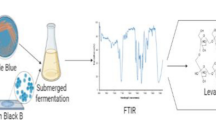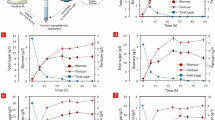Abstract
Polysialic acid (PSA) is a long-chain linear amino polysaccharide with broad application prospects; however, its relatively low molecular weight limits its application range. This study aims to explore a new fermentation method of combining the three-phase pH control strategy, three-phase mixing speed control strategy, and exogenous substance to produce high molecular weight PSA. In brief, Escherichia coli K235 6E61 (CCTCC M208088) was used as a fermentation strain. 3 g·L−1 Na5P3O10 was added to the initial medium. At 0–12 h, the mixing speed was controlled to 250 r·min−1, and the pH was maintained at 7.2. At 12–20 h, the mixing speed was increased to 400 r·min−1, the pH was changed to 6.8, and 0.75% n-hexadecane was added at hour 16. After 20 h, the mixing speed was adjusted to 250 r·min−1; the pH was restored to 7.2. Air flow was regulated to 1.2 vvm throughout the experiment. The combination fermentation strategy greatly improved the molecular weight of PSA up to 498 kDa at 32 h, which is currently the maximum molecular weight of PSA produced through microbial fermentation. The yield of PSA reached 6.27 g·L−1 at the end of fermentation (36 h), which is also currently the highest yield of PSA produced by natural bacteria. Therefore, the proposed strategy could simultaneously increase the molecular weight and yield of PSA and is of great importance to the industrial production of high molecular weight PSA.
Key points
• A new fermentation process was explored to produce high molecular weight PSA.
• The yield and molecular weight were improved by the combination fermentation strategy.
• The maximum molecular weight and highest yield of PSA were obtained.








Similar content being viewed by others
Data availability
The data that support the findings of this study are in this published article and available from the corresponding author upon reasonable request.
References
Abderrahman EM, Petridis AK, Rutishauser U (2006) Use of polysialic acid in repair of the central nervous system. P Natl Acad Sci USA 103:16989–16994. https://doi.org/10.1073/pnas.0608036103
Barrallo S, Reglero A, Revilla-Nuin B, Martinez-Blanco H, Rodriguez-Aparicio LB, Ferrero MA (1999) Regulation of capsular polysialic acid biosynthesis by temperature in Pasteurella haemolytica A2. FEBS Lett 445(2–3):325–328
Bruns S, Stark Y, Roker S, Wieland M, Drager G, Kirschning A, Stahl F, Kasper C, Scheper T (2007) Collagen biomaterial doped with colominic acid for cell culture applications with regard to peripheral nerve repair. J Biotechnol 131(3):335–345. https://doi.org/10.1016/j.jbiotec.2007.06.024
Chen F, Tao Y, Jin C, Xu Y, Lin BX (2015) Enhanced production of polysialic acid by metabolic engineering of Escherichia coli. Appl Microbiol Biotechnol 99(6):2603–2611. https://doi.org/10.1007/s00253-015-6391-x
Colley KJ, Kitajima K, Sato C (2014) Polysialic acid: biosynthesis, novel functions and applications. Crit Rev Biochem Mol Biol 49(6):498–532. https://doi.org/10.3109/10409238.2014.976606
Gregoriadis G, Jain S, Papaioannou I, Laing P (2005) Improving the therapeutic efficacy of peptides and proteins: a role for polysialic acids. Int J Pharm 300(1–2):125–130. https://doi.org/10.1016/j.ijpharm.2005.06.007
Liu JL, Wu JR, Shen FD, Yu DL, Zhang Q, Zhan XB (2010) A new strategy to enhance polysialic acid production by controlling sorbitol concentration in cultivation of Escherichia coli K235. Afr J Biotechnol 9:2422–2426
Liu JL, Zhan XB, Wu JR, Lin CC, Yu DF (2010) An efficient and large-scale preparation process for polysialic acid by Escherichia coli CCTCC M208088. Biochem Eng J 53(1):97–103. https://doi.org/10.1016/j.bej.2010.09.015
Loers G, Astafiev S, Hapiak Y, Saini V, Mishra B, Gul S, Kaur G, Schachner M, Theis T (2017) The polysialic acid mimetics idarubicin and irinotecan stimulate neuronal survival and neurite outgrowth and signal via protein kinase C. J Neurochem 142(3):392–406. https://doi.org/10.1111/jnc.14076
Mcguire EJBS (1964) The structure and chemistry of colominic acid. Biochemistry 3:247. https://doi.org/10.1021/bi00890a017
Meng C, Huang J, Ye C, Cheng W, Chen J, Li Y (2015) Comparing the performances of circular ponds with different impellers by CFD simulation and microalgae culture experiments. Bioprocess Biosyst Eng 38(7):1347–1363. https://doi.org/10.1007/s00449-015-1376-9
Muhlenhoff M, Eckhardt M, Gerardy-Schahn R (1998) Polysialic acid: three-dimensional structure, biosynthesis and function. Curr Opin Struct Biol 8:558–564. https://doi.org/10.1016/S0959-440X(98)80144-9
Oegema T, Cooper K (1983) An improved automated periodate-resorcinol method for the determination of sialic acid. Anal Biochem 133:233–238. https://doi.org/10.1016/0003-2697(83)90248-8
Sato C, Kitajima K (2013) Disialic, oligosialic and polysialic acids: distribution, functions and related disease. J Biochem 154(2):115–136. https://doi.org/10.1093/jb/mvt057
Schnaar RL, Gerardy-Schahn R, Hildebrandt H (2014) Sialic acids in the brain: gangliosides and polysialic acid in nervous system development, stability, disease, and regeneration. Physiol Rev 94(2):461–518. https://doi.org/10.1152/physrev.00033.2013
Steinhaus S, Stark Y, Bruns S, Haile Y, Scheper T, Grothe C, Behrens P (2010) Polysialic acid immobilized on silanized glass surfaces: a test case for its use as a biomaterial for nerve regeneration. J Mater Sci Mater Med 21(4):1371–1378. https://doi.org/10.1007/s10856-009-3981-0
Tan LK, Carlone GM, Borrow R (2010) Advances in the development of vaccines against Neisseria meningitidis. N Engl J Med 362(16):1511–1520. https://doi.org/10.1056/NEJMra0906357
Williams S, Neumann A, Bremer I, Su Y, Drager G, Kasper C, Behrens P (2015) Nanoporous silica nanoparticles as biomaterials: evaluation of different strategies for the functionalization with polysialic acid by step-by-step cytocompatibility testing. J Mater Sci Mater Med 26(3):125. https://doi.org/10.1007/s10856-015-5409-3
Wu J, Liu J, Zhan X, Lin C, Zhao H (2010) Enhancement of polysialic acid yield by reducing initial phosphate and feeding ammonia water to Escherichia coli CCTCC M208088. Biotechnol Bioproc E 15(4):657–663. https://doi.org/10.1007/s12257-009-3128-7
Wu JR, Fu XR, Jiang Y, Ma X, Zhang HT, Zhan XB (2017) Dipotassium phosphate improves the molecular weight stability of polysialic acid in Escherichia coli K235 culture broth. Bioresource Technol 247:30–35. https://doi.org/10.1016/j.biortech.2017.08.142
Yu LJ, Wu JR, Liu J, Zhan XB, Zheng ZY, Lin CC (2011) Enhanced curdlan production in Agrobacterium sp ATCC 31749 by addition of low-polyphosphates. Biotechnol Bioproc E 16(1):34–41
Zheng Z, Wang S, Li G, Zhan X, Lin C, Wu J, Zhu L (2013) A new polysialic acid production process based on dual-stage pH control and fed-batch fermentation for higher yield and resulting high molecular weight product. Appl Microbiol Biot 97(6):2405–2412. https://doi.org/10.1007/s00253-012-4503-4
Funding
This work was supported by the National Key Research and Development Program of China (grant no. 2017YFD0400302), the Program of Introducing Talents of Discipline to Universities (grant no. 111–2-06), and the Priority Academic Program Development of Jiangsu Higher Education Institutions.
Author information
Authors and Affiliations
Contributions
LZ contributed to the conception and design of the study. ZWY, LG, and XQP conducted the experiments. ZWY, LZ, and LG analyzed the data. ZWY and LZ wrote the manuscript. ZWY and LZ contributed to manuscript revision and read. XBZ and LZ were the paper supervisors. All authors approved the submitted version.
Corresponding authors
Ethics declarations
Ethical approval
This article does not contain any studies with human participants or animals performed by any of the authors.
Conflict of interest
The authors declare no competing interests.
Additional information
Publisher's note
Springer Nature remains neutral with regard to jurisdictional claims in published maps and institutional affiliations.
Rights and permissions
About this article
Cite this article
Yin, Z., Gao, L., Zhu, L. et al. New high-density fermentation method for producing high molecular weight polysialic acid based on the combination fermentation strategy. Appl Microbiol Biotechnol 106, 2381–2391 (2022). https://doi.org/10.1007/s00253-022-11874-6
Received:
Revised:
Accepted:
Published:
Issue Date:
DOI: https://doi.org/10.1007/s00253-022-11874-6




